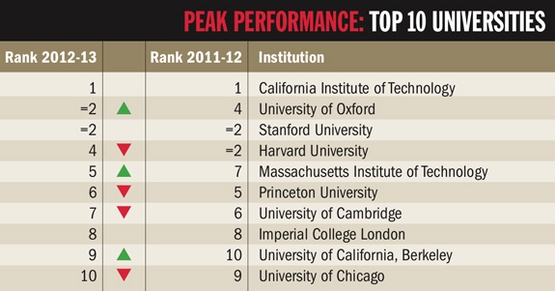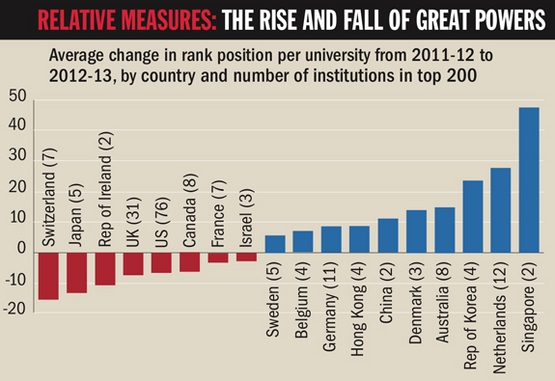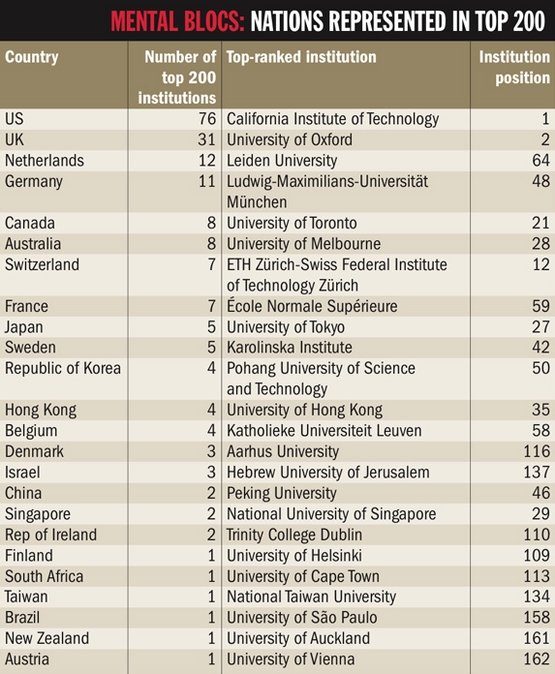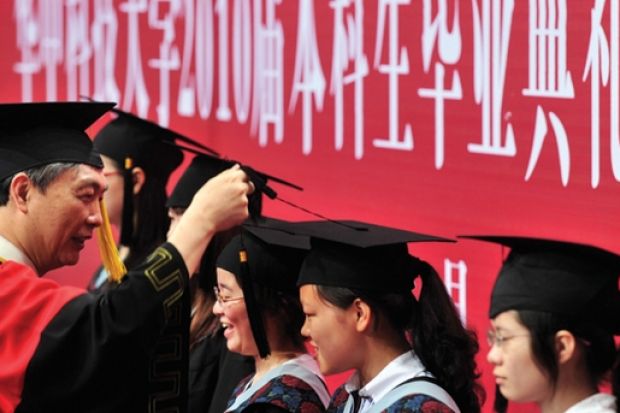Source: Getty
Rising stars: institutions in China, Taiwan, Singapore and the Republic of Korea are seeing dividends from government policies increasing funding for universities
World University Rankings 2013-2014 out now
Outside the elite Golden Triangle of Oxbridge and London, the relative performance of the UK’s research-intensive universities is slipping, analysis of the 2012-13 Times Higher Education World University Rankings shows.
Despite UK institutions on average improving scores across most criteria, a surge in performance elsewhere has seen UK universities in the top 200 slip by an average of 6.7 places.
Meanwhile, the US continues to dominate the rankings. Its universities claimed 76 places in the top 200, although 51 lost ground.
Wendy Piatt, director general of the Russell Group of research-intensive universities, said the rankings show that its institutions continue to punch above their weight but that the UK cannot afford to take the path of the US, where cuts in state investment have seriously weakened some public universities.
“The UK cannot afford to be outmanoeuvred by other countries that clearly recognise that investment in their leading universities is the key to growth,” she said.
Asian universities, especially in the Republic of Korea, Singapore, Taiwan and China, performed particularly well in the rankings, published on 3 October, rising by an average of almost 12 places.
In the UK, although the University of Oxford rose two places to joint second and Imperial College London and University College London held on to their places at eighth and 17th respectively, several other research-intensive institutions slipped.
Notable among those dropping down the table are the University of Bristol, falling eight places to 74th, and the University of St Andrews, sliding 23 places to 108th. The University of Leeds fell nine places to joint 142nd, and the University of Sheffield slipped nine places to joint 110th.
Balance of power begins to tilt
Although the UK remains the best represented country behind the US in the top 200, falls in both regions contrast with a surge in performance in Asia and Australia.
These regions saw some of the largest improvements, with the Nanyang Technological University in Singapore leaping 83 places to 86th, thanks mainly to a significant increase in research income.
Yang Wei, president of Zhejiang University and chairman of the Chinese C9 League of universities, called the shift the result of a decade of steady progress across Asia that will continue to pay off.
A time lag on the results from the most recent initiatives, such as China’s strategy to internationalise higher education and a government commitment to spend 4 per cent of gross domestic product on education, also means Chinese institutions are likely to continue to improve their positions, he added. “I think this progression will extend at least for five or ten years.”
Prospect of more cuts ‘worrying’
Although higher tuition fees have helped to protect teaching funding for 2012-13 in the UK, the Campaign for Science and Engineering estimates that science funding will drop by 12 per cent in cash terms over the course of this spending period, thanks in part to cuts in capital budgets.
UK university leaders are also thought to be worried that research and higher education budgets will come under threat if the Department for Business, Innovation and Skills is forced to find additional savings to meet government austerity targets.
Shadow higher education minister Shabana Mahmood said the rankings confirm the benefits of countries “pumping vast sums of money into higher education at a time when money is being taken out of higher education in our country”.
“That’s incredibly worrying. It goes to show you can’t rest on your laurels…because the competition across the globe is fierce,” she said.
Writing in the THE World University Rankings supplement, universities and science minister David Willetts said the rankings show that in the future “any country that stands still - or moves forward only slowly - will find itself slipping down the international league as other countries try harder, invest more and improve their research”.
However, he argued that the government’s approach, including reforms to undergraduate finance, protection for research funding and incentives for collaboration, was addressing this concern.
Several institutions buck UK trend
Across the top 400, 29 UK institutions lost ground while 12 made gains. Universities to buck the national trend of decline include the London School of Economics, rising from 47th to 39th place; the University of Edinburgh, climbing from 36th to 32nd; and the University of Warwick, rising 33 places to 124th.
Bahram Bekhradnia, director of the Higher Education Policy Institute, said that overall the results are not cause for alarm.
“What we’re seeing here is some of these countries putting a lot of emphasis on research and performing much more strongly than they did. I’d start to worry if we start to perform badly, but this is just that other people are performing better.”
The rankings used 13 performance indicators to examine universities’ strengths - in teaching, research, knowledge transfer and international outlook - using an identical methodology to 2011-12.
elizabeth.gibney@tsleducation.com


Compact and engineered for success: Caltech holds firm to top spot
Keeping things small may be the secret to the success of the California Institute of Technology, which has taken the top spot in the Times Higher Education World University Rankings for the second year in a row.
The private institution in Pasadena, California, has just 900 undergraduates and 1,200 postgraduate students. It focuses solely on science and engineering, and the social sciences and humanities connected to science.
“The fact that Caltech is doing well highlights that we focus on a small group of extraordinary people,” its president Jean-Lou Chameau told THE.
“In the case of Caltech it’s a little bit of proof that from time to time small can be beautiful.”
Caltech strengthened its performance this year in almost every one of the rankings’ 13 indicators, topping the individual table for teaching as well as subject-specific rankings for engineering and technology and the physical sciences.
Dr Chameau said features of Caltech’s culture, such as the opportunity for students to do research as early as their first year and support for interdisciplinary research, were factors behind its success rather than one specific strategy.
Being a specialist institution helped, he said. “We believe that by having some focus we can concentrate our research and be outstanding at what we do. We don’t try to do everything, but what we do we do well.”
But Dr Chameau said he believed Caltech was among a number of excellent universities, any of which could potentially top the rankings next year.
Competition was indeed tight among the top 10, all of which are in the US or the UK, and remained the same 10 as in the 2011-12 ranking.
The University of Oxford’s move from fourth to joint second reflects increases in the number of PhDs awarded, papers per academic staff member and research income - particularly from industry, which grew from £34.7 million in 2009 to £58.5 million in 2010.
Harvard University’s score fell slightly in relation to Stanford University’s, pushing it from joint second to fourth. The drop is attributable in part to dips in the proportion of international staff and students and a failure to keep up with Stanford’s growth in PhD students.
Register to continue
Why register?
- Registration is free and only takes a moment
- Once registered, you can read 3 articles a month
- Sign up for our newsletter
Subscribe
Or subscribe for unlimited access to:
- Unlimited access to news, views, insights & reviews
- Digital editions
- Digital access to THE’s university and college rankings analysis
Already registered or a current subscriber? Login




